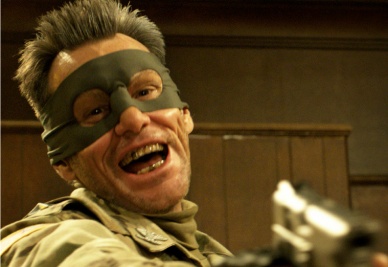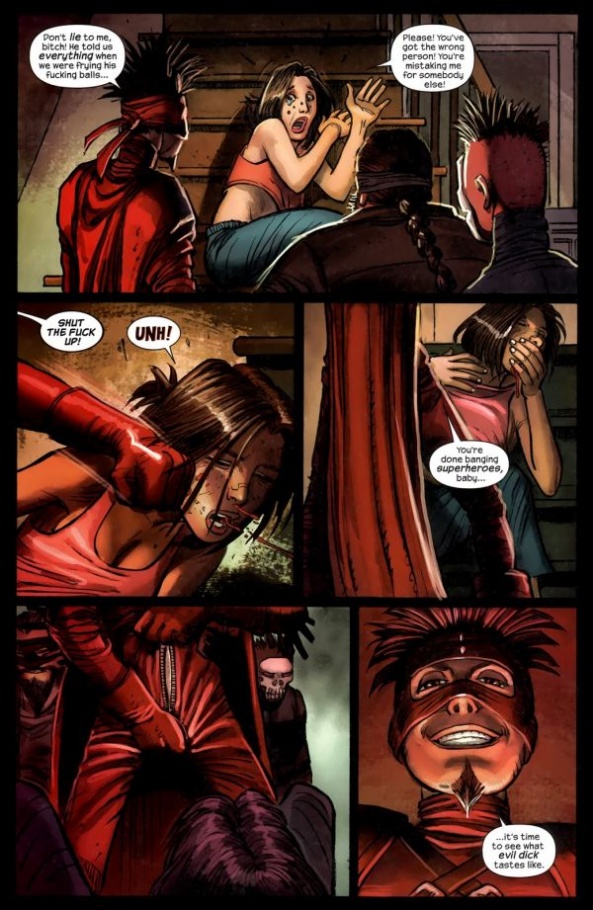So, first: the news.

Actor Jim Carrey, who we all know from any number of films both comedic and thoughtful, has recently taken to Twitter to speak out against Kick-Ass 2, a film to which he has an upcoming starring role. Carrey states:
I did Kickass a month b4 Sandy Hook and now in all good conscience I cannot support that level of violence. My apologies to e
— Jim Carrey (@JimCarrey) June 23, 2013
I meant to say my apologies to others involve with the film. I am not ashamed of it but recent events have caused a change in my heart.
— Jim Carrey (@JimCarrey) June 23, 2013
Which means that, if we can correctly assume things here, that the scene in which a character called the Mother Fucker just mows down a bunch of kids with a gun made it from the comic book to the big screen. (We’ll get to that.)
Carrey has notably taken an anti-violence stand outside of the film, having become an anti-gun activist via his social media account, and the character he plays seemingly reflects this; he only uses his baseball bat and trusty dog sidekick in order to dish out justice.
(And yes, the picture at the top of this post is very much on purpose.)
This still allows a good deal of violence to be in place, though, especially within a Mark Millar story where the hyperviolence is played up so intense that Alexander DeLarge would be proud.
With that in mind, Mark Millar has his own thoughts on this, as revealed on the Millarworld forums:
As you may know, Jim is a passionate advocate of gun-control and I respect both his politics and his opinion, but I’m baffled by this sudden announcement as nothing seen in this picture wasn’t in the screenplay eighteen months ago. Yes, the body-count is very high, but a movie called Kick-Ass 2 really has to do what it says on the tin. A sequel to the picture that gave us HIT-GIRL was always going to have some blood on the floor and this should have been no shock to a guy who enjoyed the first movie so much. My books are very hardcore, but the movies are adapted for a more mainstream audience and if you loved the tone of the first picture you’re going to eat this up with a big, giant spoon. Like Jim, I’m horrified by real-life violence (even though I’m Scottish), but Kick-Ass 2 isn’t a documentary. No actors were harmed in the making of this production! This is fiction and like Tarantino and Peckinpah, Scorcese and Eastwood, John Boorman, Oliver Stone and Chan-Wook Park, Kick-Ass avoids the usual bloodless body-count of most big summer pictures and focuses instead of the CONSEQUENCES of violence, whether it’s the ramifications for friends and family or, as we saw in the first movie, Kick-Ass spending six months in hospital after his first street altercation. Ironically, Jim’s character in Kick-Ass 2 is a Born-Again Christian and the big deal we made of the fact that he refuses to fire a gun is something he told us attracted him to the role in the first place.
Millar goes on to note that fictional violence should not be held accountable for real-life violence and more platitudes that we’ve generally come to see when in defense of work like this (that’s not a knock, mind you — just a matter of fact statement), but Millar’s main point seems to be that Kick-Ass 2 isn’t glorifying violence but instead showing a different side to it.
Respectfully to all of this, though: we kind of already told you that it was a bit too much.
That’s an article from a year and a half ago, before we moved to the website we currently stay at, and the one thing that stinks about the move is that we lost all of our old comments. (You can still find them, if you know where to look.) What I remember at the time, though, is that people both on the site and on Twitter and Reddit were telling me that I was wrong; that “Kick-Ass 2’s” gratuitous use of rape and the murder of children (my words here) wasn’t anything particular to gawk at, because these were the choices of the creators and that I was ostensibly arguing for some kind of creative censorship.
Continued belowWhich I wasn’t. What I was saying, and am still saying, is: the book goes too far for the sake of entertainment. Because if I’m correct, it’s the following scene that is in question:

and


Remember these? I do. I remember thinking it was gratuitous at the time. I remember thinking, “Oh, geez, they’re going to make a movie out of this?” And now that it’s being called into question, I have to admit that my thoughts don’t change: this is going to make one disturbing film.
So the argument of “it’s all just for entertainment” doesn’t really sit well with me, because personally, I don’t find this too entertaining. For those complaining that Man of Steel becomes disaster porn, I would argue that the above is just violent porn of a different nature.
I would argue that violence in any kind of media can be ok if there is a story to tell with it; there are plenty of examples in which violence works for a story. But with this, we are taught nothing, we learn nothing, nothing is gained by seeing these scenes. It just emphasizes that a guy named the Mother Fucker is bad news, to which I say: oh, really?
While I respect Mark Millar’s thoughts on the topic — he is the creator in question, after all — I stand by the original sentiment. It is one thing for superheroes and supervillains to fight and kill and knock down buildings or whatever on a grand scheme, but what this wonderfully titled character named the Mother Fucker is doing in this scenario is only done to show “realism.” That is now going to be in a movie in 2013, and people aren’t going to take it as a meditation on the consequences of violence; they’re just going to see violence done by a disturbed individual with little to no consequences taken against him.
Because saying that Kick-Ass is a film about the consequences of violence is the same as saying it is a satire of the superhero genre: a complete falsehood. (It’s a parody, at best, and more of a meditation on violence as an entertainment value, like a twisted iteration of Funny Games‘ horror ideas.)
Millar’s not wrong on one count: violence in fiction does not inherently beget violence in real life. But more to the point, Carrey is right in that pointless violence glorifies insensitivity. And I’m saying this after Man of Steel and it’s hour-long punch fest.
Either way, it’s a good thing we already wrote one article about this so I can just re-use all the same pictures, especially because I think now things like this:

have a much different resonance today than they did when the comic came out, which is largely Carrey’s point — and ultimately my own.



